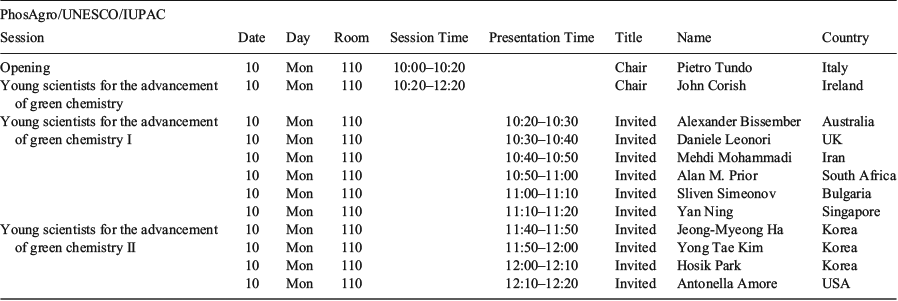Young Scientists Advancing Green Chemistry
Kenneth R. SeddonThe QUILL Research Centre, School of Chemistry and Chemical Engineering, The Queen’s University of Belfast, Stranmillis Road, Belfast BT9 5AG, Northern Ireland (UK). Email: k.seddon@qub.ac.uk

Professor Kenneth R. Seddon, OBE, is Chair of Inorganic Chemistry at the Queen's University of Belfast, and director of the QUILL Research Centre, the world-leading industrial–academic consortium that was awarded the 2006 Queens' Anniversary Prize for Higher and Further Education. QUILL was involved with implementing a full-scale process for removing mercury from natural gas streams with Petronas, for which an unprecedented three global IChemE awards (2013), and the Nicklin medal, along with the ‘Teamwork in Innovation’ Award (2014) from the Royal Society of Chemistry were presented. Professor Seddon was admitted as an Officer of the Order of the British Empire in the 2015 New Year Honours list for services to chemistry. He is also a Professor Catedrático Visitante at ITQB (New University of Lisbon), holds a Visiting Professorship of the Chinese Academy of Sciences, and is Associate Editor of the Australian Journal of Chemistry and Advisory Board member for Green Chemistry. He has published over 420 papers and patents, co-authored four books, and co-edited 12 books; he has been cited over 31,000 times and his h-index is 80. |
Australian Journal of Chemistry 69(11) 1199-1200 https://doi.org/10.1071/CHv69n11_FO
Published: 15 November 2016
Last August, I attended the 45th World Chemistry Congress at IUPAC-2015 in Busan, Korea. It was a packed program of parallel sessions (and I really do not like parallel sessions!), but I fortunately noticed the topic designated, Green Chemistry for World Needs: PhosAgro/UNESCO/IUPAC, which included a morning of sessions entitled ‘Young Scientists for the Advancement of Green Chemistry’ (http://www.iupac2015.org/main/pr_program.htm#Young Chemists Lecture) (Table 1). What an excellent morning that was – chaired by Professor Pietro Tundo, it featured 10 lectures from young chemists, none of whom I heard speak before. They were exciting, inspiring, and committed, and winners of PhosAgro/UNESCO/IUPAC research grants.

|
The PhosAgro/UNESCO/IUPAC Partnership in Green Chemistry for Life originated with an agreement signed between UNESCO and the Russian agricultural fertiliser producer ‘PhosAgro’. The program, which had its two first rounds in 2014 and 2015, aims at generating and applying new scientific knowledge in green chemistry through the promotion of the activity in this area among young scientists. It also aims at reinforcing green chemistry research in the participating institutes and cooperation between them, and at increasing awareness of policy- and decision-makers in governments, science and industry, and the public at large, of the opportunities offered by advances in green chemistry. A total of 12 awards, each up to US$30,000, have so far been awarded to young scientists around the world, and there is a current call for February 2017 (http://www.unesco.org/new/en/natural-sciences/science-technology/basic-sciences/chemistry/green-chemistry-for-life/how-to-apply/).
On my return home, I approached the Australian Journal of Chemistry to invite work from these innovative scientists to be published in a special section, and they enthusiastically agreed. Being young, not many of the speakers had uncommitted or unpublished work that they were free to submit, but I was delighted that two of the chemists whose work had most impressed me (Alex Bissember, from the University of Tasmania,[1] and Antonella (Lilly) Amore, from NREL, Golden, Colorado[2]) did accept, and these are published here. I am sure readers will agree that they have a great future ahead of them, and that their chosen specialisation of green chemistry is an exciting and essential area in which to be working.
References
[1] B. J. Deans, A. C. Bissember, J. A. Smith, Aust. J. Chem. 2016, 69, 1219.| Crossref | GoogleScholarGoogle Scholar |
[2] A. Amore, P. N. Ciesielski, C.-Y. Lin, D. Salvachúa, V. Sànchez i Nogué, Aust. J. Chem. 2016, 69, 1201.
| Crossref | GoogleScholarGoogle Scholar |


